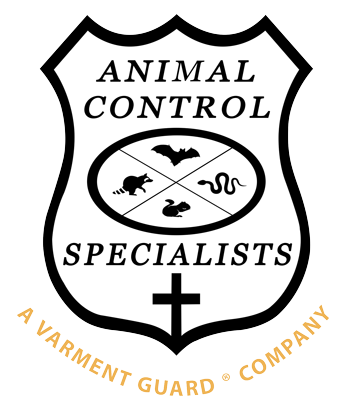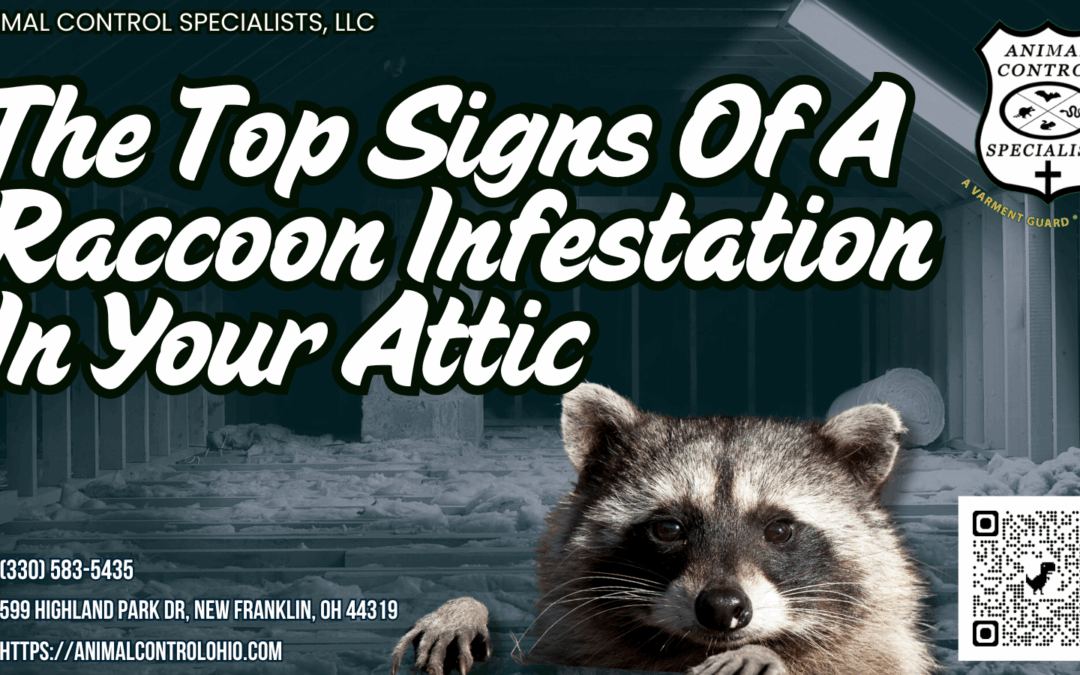The top signs of a raccoon infestation in your attic include loud noises at night, such as scratching and growls. You may also notice droppings that are dark and chunky, along with a strong urine odor. Damaged insulation is another key indicator, often compacted or wet from waste. Check for entry points, like gaps in roof vents or soffits. Unusual, foul odors can also signal their presence. Look for grease marks around these openings, as they can indicate raccoon activity. Understanding these signs can help you take the necessary steps to address the issue effectively.
Key Article Highlights
- Nocturnal noises like scratching, thumping, and vocalizations at night indicate raccoon activity in the attic.
- Dark, chunky droppings and strong urine odors can signal the presence of raccoons.
- Damaged insulation, often wet from urine, suggests nesting behavior by raccoons.
- Gaps or holes in roof vents and soffits are potential entry points for raccoons.
- Unpleasant, musky odors and grease stains around entry areas are signs of an infestation.
Noises at Night
If you hear strange noises at night, it may be time to look into the possibility of a raccoon infestation in your attic. Raccoons are nocturnal animals, meaning they are active during the night. As they move around, they can create various sounds that may alarm you. These noises often include footstep sounds, scratching, and even vocalizations.
If you notice these disturbances, it is essential to pay attention to their timing. Raccoons typically emerge after sunset and can be quite noisy as they explore their surroundings. This activity may include rummaging through insulation or knocking over objects in your attic.
Ignoring these sounds can lead to more significant issues. Raccoons can cause damage to your home and pose health risks. If you suspect a raccoon presence, it is essential to take action. You may need to inspect your attic for signs of entry points or hire a professional to handle the situation. Protecting your space is important for maintaining a peaceful home environment. By addressing these nighttime noises promptly, you can reclaim your freedom from unwanted guests in your attic.
Droppings and Urine
Noticing droppings and urine in your attic can be a clear indication of a raccoon infestation. Raccoons often create latrine sites, which are areas where they consistently leave their waste. These sites can be found in corners or hidden spaces within your attic. The droppings are typically dark and chunky, while the urine may leave stains or a strong odor.
It is important to address this issue promptly. Raccoon droppings and urine can carry diseases that may affect humans and pets. The transmission of diseases, such as leptospirosis and raccoon roundworm, can occur through contact with contaminated waste. This poses a health risk, especially if the droppings are disturbed, releasing harmful spores into the air.
If you find these signs, it is vital to take action. A professional pest control service can help safely remove the waste and assess the extent of the infestation. Ignoring the problem can lead to further complications, including structural damage and health hazards. In summary, droppings and urine are significant signs of a raccoon problem that requires immediate attention to guarantee your home remains safe and clean.
Damaged Insulation
Among the various signs of a raccoon infestation, damaged insulation in your attic is a significant indicator. Raccoons are known for their dexterity and strength. They can easily disrupt the insulation material in your attic, leading to various issues. If you suspect a raccoon problem, look for the following signs of damaged insulation:
- Trampled insulation in areas where they have traveled
- Wet spots from urine, affecting insulation quality
- Compact insulation that has been disturbed
- Unpleasant odors due to feces or urine contaminating insulation
- Gaps or holes where insulation has been pulled away
When insulation is trampled or compacted, it loses its effectiveness. This can lead to higher energy bills and decreased comfort in your home. Additionally, damaged insulation may indicate that raccoons are nesting in your attic. If you notice these signs, it is crucial to act quickly. Professional help can assess the situation and remove any wildlife safely. Ignoring these signs can lead to further damage and health risks. Protect your home by keeping an eye on your attic insulation.
Entry Points and Holes
Raccoons are resourceful animals that can find numerous ways to gain access to your attic. One common entry point is roof vents. These vents are designed to allow air circulation, but they can also serve as an invitation for raccoons. If these vents are damaged or not properly secured, raccoons can easily slip inside.
Another area to inspect is the soffit. Soffit damage can create gaps that raccoons may exploit. If you notice any holes or signs of wear in this area, it is essential to address them quickly. Raccoons are clever and can use their strong paws to widen existing openings or create new ones.
Regularly checking your home for these potential entry points is vital. Look for any signs of wear or damage, especially around roof vents and soffits. Quickly sealing any holes or gaps can help protect your attic from an unwanted raccoon invasion. Being proactive in securing these entry points is an important step in maintaining a raccoon-free home. Your freedom from these pests begins with ensuring that they cannot enter your living space.
Unusual Odors
Unusual odors can be a strong indicator of a raccoon infestation in your attic. You may notice foul, musky smells that are hard to ignore. Additionally, distinctive nighttime odors can signal the presence of these animals as they become active after dark.
Foul, Musky Smells
A strong, foul odor is often one of the first signs of a raccoon infestation in your attic. This unpleasant smell can be attributed to the raccoon's scent glands. As they move around, they leave behind grease marks and odors that can become very noticeable. Recognizing these odors early can help you address the problem before it worsens.
Some common characteristics of these foul, musky smells include:
- A pungent, earthy scent that lingers
- An odor that intensifies at night
- A strong smell that resembles ammonia
- A musty odor mixed with rotting material
- Grease marks or stains around entry points
If you notice these signs, it's vital to investigate further. The presence of these smells indicates that raccoons may be living in your attic. They can cause damage and pose health risks. Taking action quickly can help protect your home and restore its comfort. Always consider consulting a professional for safe removal and prevention strategies. Recognizing foul odors is an essential step in managing a raccoon infestation effectively.
Distinctive Nighttime Odors
Nighttime often brings with it distinctive odors that can signal a raccoon presence in your attic. Raccoons have strong scent glands that they use to mark their territory. If you notice unusual smells at night, it may be a sign that these creatures are nearby.
The odors can vary but are often described as musky and pungent. These scents can come from raccoons' waste, which is one of the primary odor sources. Their feces and urine carry strong smells that can seep into your living space.
Additionally, if raccoons have nested in your attic, their presence may lead to more unusual odors as they bring in food scraps or other items. This can create a buildup of smells that can become quite overwhelming.
Taking note of these nighttime odors is essential for identifying a potential raccoon infestation. If you experience these distinct scents, it is advisable to investigate further. Addressing the issue early can help you regain control of your home and maintain a comfortable living environment.
Raccoon Tracks and Prints
When trying to identify a raccoon infestation, one of the key indicators can be the presence of their tracks and prints. Raccoons have distinct foot shapes that can help in track identification. Their prints show a unique arrangement of toes and claws, allowing us to recognize their presence easily.
To identify raccoon tracks, look for these specific features:
- Size: Raccoon tracks are about 2 to 4 inches long.
- Shape: The front paw has five toes, while the back paw has four.
- Gait patterns: Raccoons have a distinctive walking style, often leaving prints that show a hopping motion.
- Claw marks: You may see visible claw marks in their tracks.
- Location: Look near entry points or areas where food is present.
Frequently Asked Questions
How Can I Prevent Raccoons From Entering My Attic?
To prevent raccoons from entering your attic, focus on entry sealing, utilize noise and light repellents, and consider smell repellents. For effective results, seeking professional assistance may be beneficial to guarantee thorough protection.
Are Raccoons Dangerous to Pets or Children?
Raccoons can exhibit aggression if they feel threatened, posing potential risks to pets and children. Ensuring pet safety is essential by supervising outdoor activities and securing areas where raccoons may enter, reducing the chance of conflict.
When Is Raccoon Mating Season?
Raccoon mating season typically occurs from late winter to early spring. During this time, mating behaviors become evident, followed by a gestation period of about 63 days, leading to the birth of young raccoons in late spring.
What Should I Do if I See a Raccoon During the Day?
If you observe a raccoon during the day, it may indicate daytime foraging due to urban adaptation. Maintain distance and avoid interaction, as this behavior could signal distress or a potential issue with local wildlife.
How Can I Safely Remove Raccoons From My Attic?
To safely remove raccoons from your attic, consider humane removal methods, utilizing DIY traps. Make certain the traps are checked regularly, and once captured, relocate the raccoons to a suitable environment away from your home.

